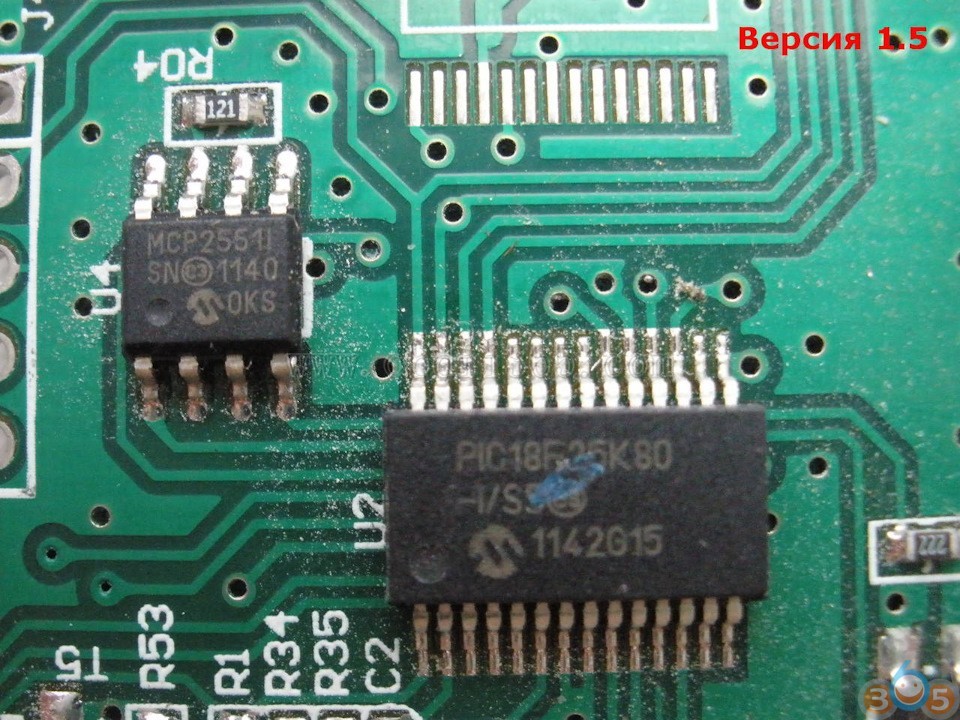When diving into the world of car diagnostics, you’ll likely encounter the ELM327 OBD2 Bluetooth adapter. It’s a popular tool for DIY enthusiasts and professionals alike, allowing you to access your car’s On-Board Diagnostics (OBD) system using your smartphone or computer. However, you might quickly find yourself facing a choice between versions, notably ELM327 OBD2 Bluetooth V2.1 and V1.5. While they may look identical from the outside, significant differences under the hood impact their performance and compatibility. Let’s break down what sets these versions apart to help you choose the right one for your needs.
Key Differences Between ELM327 V1.5 and V2.1 Adapters
The core distinction between ELM327 V1.5 and ELM327 OBD2 Bluetooth V2.1 adapters lies in their internal microcontrollers and firmware. Visually, it’s almost impossible to tell them apart, but the components inside and how they operate make all the difference.
ELM327 Version 1.5 PCB Layout: A close-up view of the circuit board showing component arrangement.
Version 2.1 emerged around 2014 and is primarily a Chinese adaptation of the ELM327 adapter. It’s crucial to understand that while adapters based on the original Elmelectronics chips (version 2.1 chip alone costing around $21 for manufacturers) are available, they are considerably more expensive. In contrast, ELM327 OBD2 Bluetooth V2.1 adapters are often built as a cost-effective alternative.
Unlike ELM327 V1.5 (and V1.4), which utilize “borrowed” firmware based on the original ELM327 code, version 2.1 represents a completely independent development. Chinese developers created and tested these adapters, reportedly focusing on compatibility with popular diagnostic apps like Torque and Scanmaster, where they generally perform adequately.
ELM327 Version 2.1 Adapter Internal Components: Image showing the internal PCB of a v2.1 ELM327 adapter.
Detailed View of ELM327 V2.1 PCB: Closer inspection of the circuit board components in an ELM327 version 2.1 adapter.
The drive to reduce costs and size in ELM327 OBD2 Bluetooth V2.1 adapters has led to compromises in quality and reliability. Functionality issues arise because version 2.1 may not fully support or incorrectly implements certain ELM327 AT commands. Furthermore, some adapters behave erratically, failing to return responses from vehicle modules or only providing partial data. For users, this translates to the adapter pairing with diagnostic software but then failing to connect to the car’s computer or properly identify the vehicle. While they might work for basic OBDII protocol functions, deeper diagnostics can be problematic.
Protocol Support: Where V2.1 Falls Short
A significant limitation of ELM327 OBD2 Bluetooth V2.1 adapters is their compromised support for certain OBD protocols. Specifically, they often lack full or any support for ISO9141-2 and ISO14230-4 (KWP2000) protocols. For vehicles relying on these protocols, communication with the Engine Control Unit (ECU) is often impossible.
You can sometimes identify a version 2.1 adapter by testing its response to specific AT commands. If commands like ATIB10, ATAL, and ATSW00 return a question mark “?” instead of the expected “OK” for ATIB10 (and the adapter version), it indicates a lack of support for non-standard protocols. This is particularly relevant for users needing to use initialization lines for connecting to older ECUs (like those in some VAZ, Chery Tiggo, Nissan, Toyota JDM vehicles, and systems like January, Mikas, Delphi). If your setup requires specific initialization strings, an ELM327 OBD2 Bluetooth V2.1 adapter is likely to fail.
Choosing the Right ELM327 Version for Your Needs
So, which version should you choose? Your decision hinges on your vehicle and diagnostic needs.
Opt for ELM327 V1.5 if:
- You own a car manufactured before 2005.
- You drive a VAZ or similar vehicle.
- You intend to use specialized diagnostic software beyond common apps.
- You need to register initialization strings to establish a connection with your car’s control unit.
ELM327 OBD2 Bluetooth V2.1 might suffice if:
- You have a modern car, generally less than 10 years old.
- You don’t require custom initialization lines.
- You plan to use mainstream diagnostic applications like Torque or similar OBDII-focused software.
In Conclusion
While ELM327 OBD2 Bluetooth V2.1 adapters offer a budget-friendly entry into car diagnostics, their limitations, particularly in protocol support and reliability, are crucial to consider. For broader vehicle compatibility and more advanced diagnostic tasks, ELM327 V1.5 remains the more dependable choice. Understanding these differences ensures you select the right tool for effective car diagnostics.
